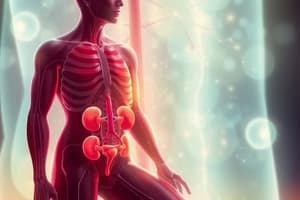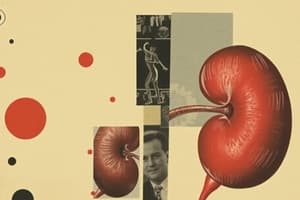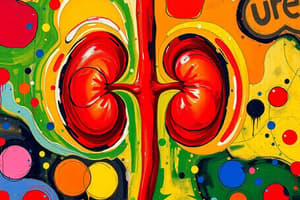Podcast
Questions and Answers
What is the primary function of excretion in living organisms?
What is the primary function of excretion in living organisms?
- To store excess nutrients for later use
- To regulate body temperature
- To eliminate metabolic waste and toxic substances (correct)
- To produce energy for metabolic processes
In mammals, through which organ is carbon dioxide primarily excreted as a waste product of respiration?
In mammals, through which organ is carbon dioxide primarily excreted as a waste product of respiration?
- Kidneys
- Skin
- Liver
- Lungs (correct)
Why is urea considered a toxic substance in the human body?
Why is urea considered a toxic substance in the human body?
- It disrupts the function of digestive enzymes.
- It interferes with oxygen transport in the blood.
- High concentrations can damage cells and tissues. (correct)
- It inhibits the production of red blood cells.
Which sequence correctly describes the flow of urine after it leaves the kidneys?
Which sequence correctly describes the flow of urine after it leaves the kidneys?
What is the role of the hepatic portal vein in the processing of amino acids?
What is the role of the hepatic portal vein in the processing of amino acids?
What process is defined as the removal of the nitrogen-containing part of an amino acid?
What process is defined as the removal of the nitrogen-containing part of an amino acid?
Which of the following best describes the function of the renal artery?
Which of the following best describes the function of the renal artery?
In the context of kidney function, what is the role of nephrons?
In the context of kidney function, what is the role of nephrons?
During urine formation, what process involves the return of water, glucose, and ions back into the blood?
During urine formation, what process involves the return of water, glucose, and ions back into the blood?
How does the kidney respond when a person is dehydrated and has not drunk enough water?
How does the kidney respond when a person is dehydrated and has not drunk enough water?
Flashcards
Excretion
Excretion
The process by which organisms remove metabolic waste products and other toxic substances from their body.
Urea
Urea
A waste product produced in the liver from excess proteins and amino acids, which is toxic in high concentrations.
Kidneys
Kidneys
Organs that remove urea, excess water, and excess ions from the blood to produce urine.
Ureters
Ureters
Signup and view all the flashcards
Bladder
Bladder
Signup and view all the flashcards
Urethra
Urethra
Signup and view all the flashcards
Deamination
Deamination
Signup and view all the flashcards
Glomeruli
Glomeruli
Signup and view all the flashcards
Reabsorption
Reabsorption
Signup and view all the flashcards
Nephrons
Nephrons
Signup and view all the flashcards
Study Notes
- Excretion is how organisms remove metabolic waste and toxic substances.
- All living cells undergo numerous metabolic reactions.
- Respiration yields energy, water, and carbon dioxide.
- Animal cells require energy and may utilize water, but carbon dioxide is a waste product.
- In mammals, carbon dioxide from respiration gets excreted by the lungs.
Urea
- Urea, produced in the liver, is a waste product in humans.
- Too much urea in blood is toxic.
- Kidneys filter urea from the blood, along with excess water and ions, and then produce urine.
- Urine flows from the kidneys through the ureters to the bladder, where it is stored.
- Urine exits the body through the urethra when the sphincter muscle relaxes.
How Urea is Produced (Role of the Liver)
- Urea forms in the liver from excess proteins and amino acids.
- Animals, including humans, cannot store proteins or amino acids.
- Excess amino acids get broken down to form urea.
- Digestive enzymes break down proteins into amino acids in the stomach, duodenum, and ileum.
- These amino acids are absorbed into blood capillaries in the villi of the ileum.
- Blood capillaries join to form the hepatic portal vein, which transports amino acids to the liver.
- The liver allows some amino acids to flow in the blood to other areas.
- Excess amino acids get stored as carbohydrates through the removal of the nitrogen-containing amino group.
- The process of removing the nitrogen-containing part of an amino acid is deamination.
- The amino group from deamination turns into urea, then dissolves in the blood plasma to be excreted by the kidneys.
The Kidneys
- Kidneys are solid, oval, red-brown structures enclosed by a transparent membrane and attached to the abdominal cavity's back.
- The kidneys constantly remove toxic urea from the blood, excreting it in urine.
- The renal artery, branching from the aorta, delivers oxygenated blood.
- The renal vein carries deoxygenated blood from the kidneys to the vena cava.
- The ureter, a tube, runs from each kidney to the bladder in the lower abdomen.
Microscopic Structure of the Kidneys
- Kidney tissue contains capillaries and renal tubules.
- A cut through the kidney reveals a dark outer cortex and a lighter inner medulla.
- The pelvis refers to the space where the ureter connects to the kidney.
Nephrons
- Kidneys consist of thousands of tiny tubules called nephrons.
- Each nephron begins in the cortex, loops into the medulla, back into the cortex, and then descends into the medulla.
- Nephrons join with the ureter.
Urine Formation
- Blood flows into the kidney via the renal artery, which divides to form glomeruli (tiny, coiled capillaries).
- As blood flows through a glomerulus, it gets filtered.
- Small molecules like water, urea, glucose, and ions pass through to form filtrate, while larger molecules and blood cells cannot pass through.
- All filtrate molecules enter the nephron.
- Useful substances, like water and glucose, are reabsorbed back into the blood.
- Reabsorption involves the fluid flowing through the nephron.
- The final liquid, urine, contains urea, salts, and water then flows out of the kidneys, along the ureters, and into the bladder for storage before excretion through the urethra.
- Kidneys efficiently reabsorb water; humans reabsorb over 99% of water entering the tubules and filter 170 dm³ of water, but produce only 1.5 dm³ of urine daily.
- Urine volume depends on excess water; more liquid intake leads to diluted urine excretion.
- Less fluid intake or water loss through sweating results in concentrated urine.
- The colour of urine indicates hydration levels.
Studying That Suits You
Use AI to generate personalized quizzes and flashcards to suit your learning preferences.





